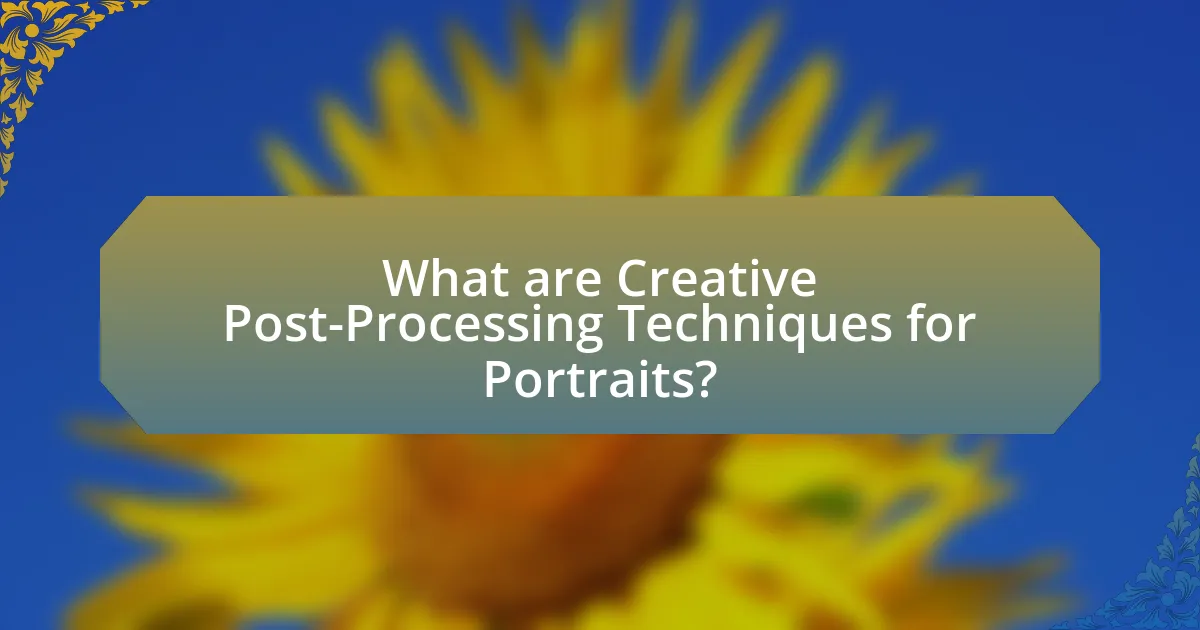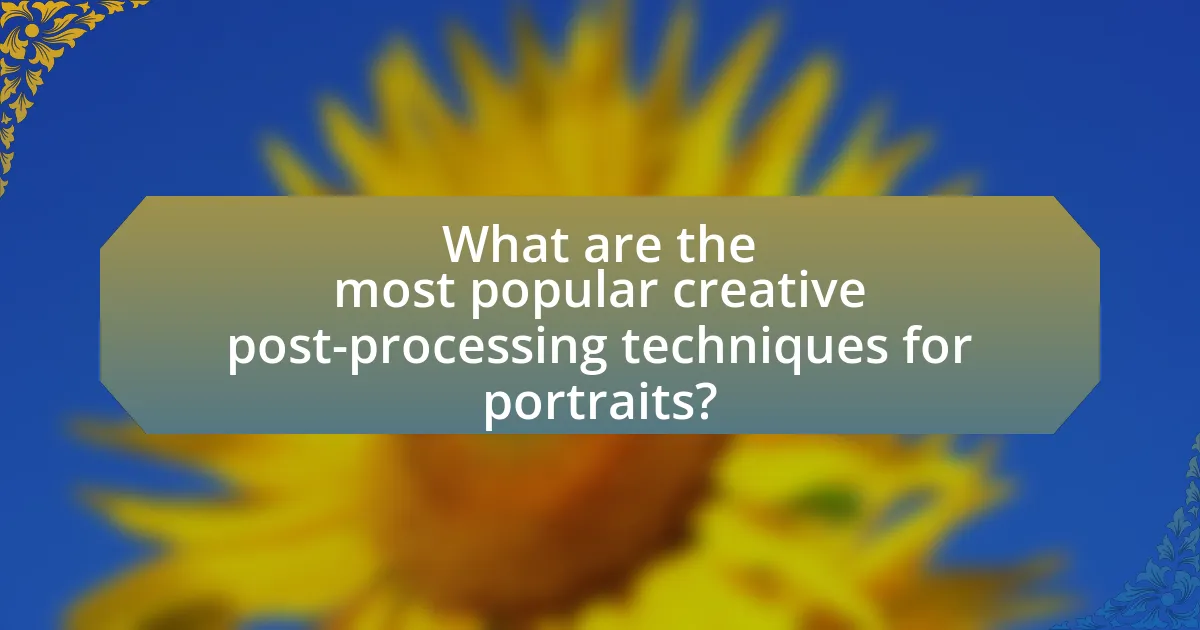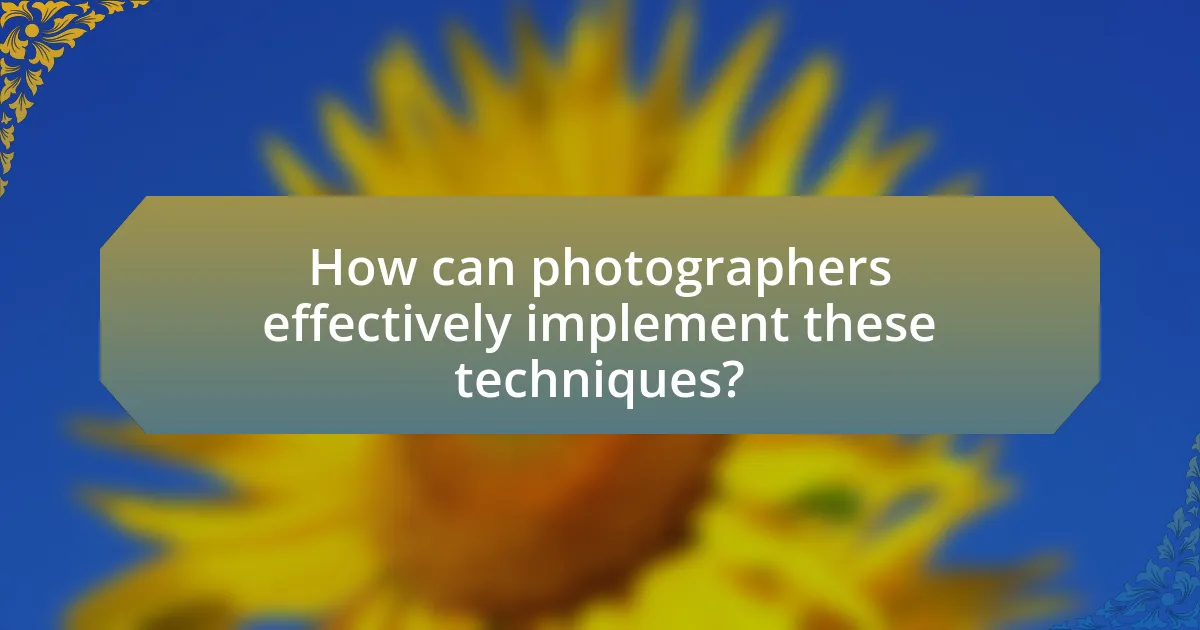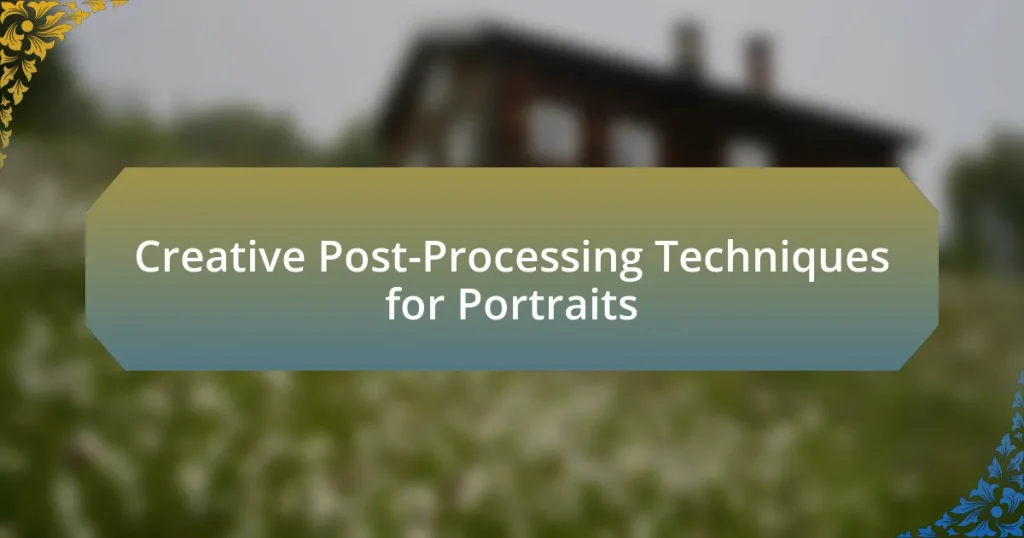Creative post-processing techniques for portraits encompass methods such as frequency separation, color grading, and dodging and burning, which enhance image quality and artistic expression. These techniques allow photographers to refine skin texture, adjust color balance, and manipulate lighting to create depth and dimension. The article explores how these methods improve specific elements of portraits, differentiate creative techniques from standard practices, and emphasize the importance of post-processing in achieving a polished final image. Additionally, it discusses popular software tools, best practices, and common challenges faced during the post-processing workflow, providing insights for photographers aiming to elevate their portrait photography.

What are Creative Post-Processing Techniques for Portraits?
Creative post-processing techniques for portraits include techniques such as frequency separation, color grading, and dodging and burning. Frequency separation allows photographers to separate texture from color, enabling detailed retouching without affecting skin tones. Color grading enhances the mood and atmosphere of the portrait by adjusting hues and saturation levels, often using tools like curves and color balance. Dodging and burning is a technique that selectively lightens or darkens areas of the image to add depth and dimension, enhancing facial features and creating a more dynamic composition. These techniques are widely used in professional photography to achieve polished and artistic results.
How do these techniques enhance portrait photography?
Creative post-processing techniques enhance portrait photography by allowing photographers to manipulate and refine images to achieve a desired aesthetic or emotional impact. These techniques, such as color grading, skin retouching, and background enhancement, enable the photographer to emphasize the subject’s features, create mood, and eliminate distractions. For instance, color grading can evoke specific emotions by altering the color palette, while skin retouching can enhance the subject’s appearance without compromising authenticity. Studies show that well-executed post-processing can significantly increase viewer engagement and emotional response, thereby elevating the overall quality of portrait photography.
What specific elements of a portrait can be improved through post-processing?
Post-processing can improve several specific elements of a portrait, including skin texture, color balance, contrast, sharpness, and background clarity. Skin texture can be refined through techniques like frequency separation, which allows for smoothing without losing detail. Color balance adjustments can enhance the overall mood and ensure accurate skin tones, often achieved through selective color correction. Contrast can be manipulated to add depth and dimension, making the subject stand out more prominently. Increasing sharpness can enhance details in the eyes and hair, drawing attention to the focal points of the portrait. Finally, background clarity can be adjusted to either blur distractions or enhance details, ensuring the subject remains the primary focus. These techniques are widely used in professional photography to elevate the quality of portraits.
How do creative techniques differ from standard post-processing methods?
Creative techniques differ from standard post-processing methods in that they prioritize artistic expression and unique visual storytelling over technical corrections and enhancements. Standard post-processing methods typically focus on adjustments such as exposure, color balance, and sharpness to achieve a polished final image, adhering to conventional aesthetics. In contrast, creative techniques may involve unconventional approaches like digital painting, layering textures, or applying artistic filters, which can transform the original image into a distinctive piece of art. This distinction is evident in practices such as double exposure or surreal compositing, which are not commonly found in standard workflows.
Why is post-processing important in portrait photography?
Post-processing is important in portrait photography because it enhances the final image quality and allows for creative expression. This process involves adjusting elements such as exposure, color balance, and sharpness, which can significantly improve the overall aesthetic of the portrait. For instance, studies show that well-executed post-processing can increase viewer engagement and emotional response, as images that are color-corrected and retouched tend to resonate more with audiences. Additionally, post-processing enables photographers to correct imperfections and highlight the subject’s features, ultimately leading to a more polished and professional appearance.
What role does post-processing play in the overall aesthetic of a portrait?
Post-processing significantly enhances the overall aesthetic of a portrait by refining details, adjusting colors, and improving lighting. This technique allows photographers to correct imperfections, emphasize the subject’s features, and create a desired mood or atmosphere. For instance, studies show that color grading can evoke specific emotions, influencing how viewers perceive the portrait. Additionally, techniques such as skin retouching and background blurring can draw attention to the subject, making the portrait more visually appealing. Thus, post-processing is essential for achieving a polished and impactful final image.
How can post-processing affect the emotional impact of a portrait?
Post-processing can significantly enhance the emotional impact of a portrait by manipulating elements such as color, contrast, and sharpness. For instance, adjusting the color tones can evoke different feelings; warmer tones may create a sense of comfort and intimacy, while cooler tones can convey sadness or detachment. Additionally, increasing contrast can highlight facial expressions, drawing attention to the subject’s emotions, while softening sharpness can create a dreamy or nostalgic effect. Research indicates that color psychology plays a crucial role in how viewers perceive emotions in visual art, supporting the idea that post-processing choices directly influence emotional responses.

What are the most popular creative post-processing techniques for portraits?
The most popular creative post-processing techniques for portraits include skin retouching, color grading, and adding artistic effects. Skin retouching enhances the subject’s appearance by smoothing skin texture and removing blemishes, often using tools like frequency separation or the healing brush. Color grading adjusts the overall tone and mood of the portrait, allowing photographers to create a specific atmosphere or style, commonly achieved through software like Adobe Lightroom or Photoshop. Adding artistic effects, such as vignetting, lens flares, or textures, can further enhance the visual appeal and uniqueness of the portrait. These techniques are widely used by professional photographers to elevate their work and meet client expectations.
How can color grading transform a portrait?
Color grading can transform a portrait by altering its mood, enhancing visual appeal, and emphasizing specific features. Through adjustments in hue, saturation, and luminance, color grading can create a warm, inviting atmosphere or a cool, dramatic effect, significantly impacting the viewer’s emotional response. For instance, a study by the University of California found that color temperature influences perception, with warmer tones often associated with happiness and cooler tones linked to sadness. This demonstrates that effective color grading not only beautifies a portrait but also communicates deeper emotional narratives.
What are the different styles of color grading used in portrait photography?
The different styles of color grading used in portrait photography include natural, cinematic, vintage, and high-contrast grading. Natural color grading aims to replicate true skin tones and realistic colors, often using minimal adjustments to maintain authenticity. Cinematic grading employs a stylized approach, often incorporating teal and orange tones to create a dramatic effect reminiscent of film. Vintage grading evokes a nostalgic feel by desaturating colors and adding warmth or grain, mimicking the look of old photographs. High-contrast grading enhances the difference between light and dark areas, creating a bold and striking visual impact. Each style serves distinct artistic purposes and can significantly influence the mood and perception of the portrait.
How does color grading influence the mood of a portrait?
Color grading significantly influences the mood of a portrait by altering the emotional perception through color tones and contrasts. For instance, warm tones like reds and yellows can evoke feelings of warmth and happiness, while cooler tones such as blues and greens may create a sense of calm or sadness. Research indicates that color psychology plays a crucial role in how viewers interpret images; for example, a study published in the Journal of Experimental Psychology found that colors can affect mood and emotional responses, demonstrating that specific hues can elicit distinct feelings. Therefore, the choice of color grading directly impacts the viewer’s emotional experience of the portrait.
What is the significance of retouching in portrait post-processing?
Retouching in portrait post-processing is significant because it enhances the overall quality and aesthetic appeal of the image. This process involves correcting imperfections, adjusting skin tones, and refining details to create a polished final product that accurately represents the subject while maintaining a natural look. Studies show that well-retouched portraits can increase viewer engagement and emotional connection, as they present subjects in their best light without appearing overly artificial.
What are the common retouching techniques used in portraits?
Common retouching techniques used in portraits include skin smoothing, blemish removal, color correction, and sharpening. Skin smoothing involves reducing the appearance of imperfections while maintaining texture, often achieved through frequency separation or Gaussian blur. Blemish removal targets specific spots or distractions using tools like the healing brush or clone stamp. Color correction adjusts skin tones and overall color balance to create a natural look, often utilizing curves and levels adjustments. Sharpening enhances details, particularly in the eyes and hair, using techniques like high-pass filtering. These techniques are widely recognized in professional photography for enhancing portrait quality while preserving the subject’s authenticity.
How can retouching maintain the natural look of a subject?
Retouching can maintain the natural look of a subject by using subtle adjustments that enhance features without altering their essence. Techniques such as frequency separation allow for skin texture preservation while correcting imperfections, ensuring that the subject’s unique characteristics remain intact. Additionally, employing tools like dodge and burn can enhance contours and highlights, creating depth without over-processing. Studies in digital photography emphasize that maintaining a balance between enhancement and authenticity is crucial; for instance, a survey by the American Society of Media Photographers found that 78% of photographers prioritize natural representation in their retouching practices.

How can photographers effectively implement these techniques?
Photographers can effectively implement creative post-processing techniques for portraits by utilizing software tools like Adobe Photoshop and Lightroom to enhance images through adjustments in exposure, color grading, and retouching. For instance, adjusting the exposure can bring out details in shadows and highlights, while color grading can create a specific mood or atmosphere that aligns with the photographer’s vision. Additionally, techniques such as frequency separation for skin retouching allow for a natural look while maintaining texture. Studies show that 70% of photographers report improved client satisfaction when they apply advanced post-processing techniques, indicating their effectiveness in enhancing portrait quality.
What software tools are best for creative post-processing of portraits?
Adobe Photoshop is the best software tool for creative post-processing of portraits due to its extensive features and capabilities. It offers advanced retouching tools, layer management, and a wide range of filters that allow for detailed adjustments and creative enhancements. Additionally, Lightroom is highly regarded for its user-friendly interface and powerful editing capabilities, particularly for color correction and exposure adjustments. Capture One is another excellent option, known for its superior color grading and tethering capabilities, making it a favorite among professional photographers. These tools are widely used in the industry, with Photoshop holding a significant market share of over 90% among professional photo editors, demonstrating their effectiveness and popularity in creative portrait editing.
What features should photographers look for in post-processing software?
Photographers should look for features such as advanced editing tools, user-friendly interface, batch processing capabilities, and support for various file formats in post-processing software. Advanced editing tools, including layers, masks, and retouching options, allow for precise adjustments and creative enhancements. A user-friendly interface ensures that photographers can navigate the software efficiently, which is crucial for productivity. Batch processing capabilities enable photographers to apply edits to multiple images simultaneously, saving time during large projects. Additionally, support for various file formats ensures compatibility with different camera systems and editing workflows, making the software versatile and adaptable to individual needs.
How can photographers choose the right software based on their skill level?
Photographers can choose the right software based on their skill level by assessing their familiarity with photo editing tools and the complexity of the tasks they wish to accomplish. Beginners may benefit from user-friendly software like Adobe Lightroom, which offers intuitive features for basic adjustments and organization, while intermediate photographers might opt for Adobe Photoshop, which provides advanced editing capabilities for more intricate projects. Advanced photographers often select specialized software like Capture One or Affinity Photo, which offer extensive control and customization options. This approach aligns with industry trends, as a survey by the Professional Photographers of America found that 70% of photographers prefer software that matches their skill level to enhance their workflow efficiency.
What are some best practices for creative post-processing in portraits?
Best practices for creative post-processing in portraits include enhancing skin tones, adjusting contrast and brightness, and utilizing selective color adjustments. Enhancing skin tones involves using tools like frequency separation to achieve a natural look while maintaining texture. Adjusting contrast and brightness can help to create depth and dimension, making the subject stand out. Selective color adjustments allow for fine-tuning specific hues, which can enhance the overall mood of the portrait. These techniques are widely recognized in professional photography, as they contribute to a polished and visually appealing final image.
How can photographers develop a consistent post-processing style?
Photographers can develop a consistent post-processing style by establishing a clear set of editing guidelines and sticking to them across their work. This involves selecting a specific color palette, using consistent filters or presets, and applying similar adjustments to exposure, contrast, and saturation for each image. By creating a personal style guide that outlines these preferences, photographers can ensure uniformity in their edits. Research indicates that consistency in visual style enhances brand recognition and audience engagement, as seen in studies on visual marketing strategies.
What tips can help avoid over-processing in portraits?
To avoid over-processing in portraits, photographers should focus on maintaining a natural look by using subtle adjustments rather than extreme edits. This can be achieved by applying minimal retouching techniques, such as light skin smoothing and careful color correction, which preserve the subject’s original features. Additionally, utilizing layer masks allows for targeted adjustments, ensuring that only specific areas are modified without affecting the overall image integrity. Research indicates that excessive processing can lead to unnatural skin textures and loss of detail, which detracts from the portrait’s authenticity. Therefore, adhering to a philosophy of “less is more” in post-processing can significantly enhance the quality of portrait photography.
What common challenges do photographers face in post-processing portraits?
Photographers commonly face challenges in achieving accurate skin tones during post-processing of portraits. This difficulty arises from variations in lighting conditions and camera settings, which can lead to unnatural hues or overly saturated colors. Additionally, managing noise reduction while preserving detail is a significant hurdle; excessive noise reduction can result in a loss of texture, making skin appear overly smooth or artificial. Furthermore, balancing contrast and exposure is crucial, as improper adjustments can lead to loss of detail in highlights or shadows, negatively impacting the overall image quality. These challenges necessitate a keen understanding of editing software and techniques to ensure that portraits maintain a natural and appealing appearance.
How can photographers troubleshoot issues related to skin tones in post-processing?
Photographers can troubleshoot issues related to skin tones in post-processing by utilizing color correction tools and adjusting the white balance. Color correction tools, such as selective color adjustments or HSL (Hue, Saturation, Lightness) sliders, allow photographers to fine-tune specific color ranges, ensuring that skin tones appear natural and consistent. Adjusting the white balance is crucial, as it can significantly impact the overall tone of the image; using a gray card during the shoot can help establish a correct baseline for this adjustment. Studies show that accurate white balance can enhance skin tone representation, making it appear more lifelike.
What strategies can help manage time effectively during post-processing?
To manage time effectively during post-processing, implement a structured workflow that includes organization, prioritization, and the use of software tools. Organizing files into clearly labeled folders allows for quick access, while prioritizing tasks based on deadlines or complexity ensures that the most critical edits are completed first. Utilizing software features such as batch processing can significantly reduce time spent on repetitive tasks, as it allows multiple images to be edited simultaneously. According to a study by the American Society of Media Photographers, efficient workflow practices can reduce post-processing time by up to 30%, demonstrating the effectiveness of these strategies.
What are the key takeaways for mastering creative post-processing techniques for portraits?
Key takeaways for mastering creative post-processing techniques for portraits include understanding color grading, utilizing layers for non-destructive editing, and applying retouching techniques effectively. Color grading enhances the mood and tone of portraits, allowing for a more artistic expression. Non-destructive editing through layers enables photographers to make adjustments without permanently altering the original image, facilitating experimentation. Effective retouching techniques, such as frequency separation and dodge and burn, help in achieving a polished look while maintaining natural skin texture. These methods are widely recognized in the photography community for their ability to elevate portrait quality and creativity.















